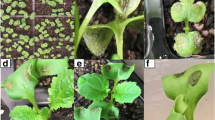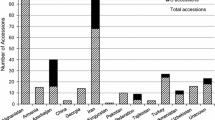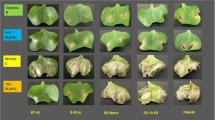Abstract
Field host resistance against the white leaf spot pathogen Pseudocercosporella capsellae was determined across one hundred and seventeen Brassica napus, eleven B. juncea, four B. rapa, five B. oleracea, eight B. fruticulosa and one B. carinata genotypes. Of the one hundred and seventeen B. napus, there were seven lines of B. napus containing weedy crucifer introgression, sixteen lines with B. carinata introgression, fifty six lines of synthetic B. napus from B. juncea into B. carinata and B. rapa into B. oleracea, while remaining B. napus were commercial varieties from Australia. There was wide and significant (P < 0.001) variation across the test genotypes in terms of relative disease development assessed either as % leaves diseased index (%LDI), values ranging from 0 to 68, or % leaves collapsed index (%LCI), with values ranging from 0 to 38. B. rapa subsp. oleifera ATC 95966 Bo was the most resistant genotype to white leaf spot disease (%LDI = 0, %LCI = 0). Very high resistance was observed in all five B. oleracea genotypes (%LDI < 13, %LCI ≤ 10) and of these B. oleracea var. gongylodes Tronchuda with %LDI = 1.0 and %LCI = 2.5 and B. oleracea var. sabellica Kailan with %LDI = 2.4 and %LCI = 2.0 were the most resistant. Eight B. fruticulosa genotypes showed high resistance with %LDI < 15 and ≤ 10 %LCI. While eight out of twelve B. juncea varieties were highly susceptible, there was a range in %LDI of 5–58 and %LCI of 10–30 and with both Montara and VT 535 G showing best resistance of this species. Amongst B. napus genotypes, more than ten of the Australian commercial cultivars demonstrated comparatively higher resistance to white leaf spot disease than the most resistant genotypes with weedy introgression or synthetic B. napus, with commercial cultivars Oscar and Stubby considered to be highly resistant. These resistances offer unique opportunities both for direct deployment where white leaf spot is severe and for oilseed and vegetable Brassica spp. breeding programs to develop commercial cultivars with effective resistance.

Similar content being viewed by others
References
Amelung D, Daebeler F (1988) White spot (Pseudocercosporella capsellae ell. Et Ev. Deighton) - a new disease of winter rape in the German Democratic Republic. Nachrichtenbl. Pflanzenschutz DDR 42:73–74
Atri C, Kumar B, Kumar H, Kumar S, Sharma S, Banga SS (2012) Development and characterization of Brassica juncea–B. fruticulosa introgression lines exhibiting resistance to mustard aphid (Lipaphis erysimi Kalt). BMC Genet 13:104
Barbetti MJ (1987) Effects of three foliar diseases on biomass and seed yield for 11 cultivars of subterranean clover. Plant Dis 71:350–353
Barbetti MJ, Khangura R (2000) Fungal diseases of canola in Western Australia. Dept Agriculture and Food Western Australia, Bull 4406:15 pp
Barbetti MJ, Nichols PGH (2005) Field performance of subterranean clover germplasm in relation to severity of Cercospora disease. Australas Plant Pathol 34:197–201
Barbetti MJ, Sivasithamparam K (1981) Pseudocercosporella capsellae and Myrothecium verrucaria on rapeseed in Western Australia. Australas Plant Pathol 10:43–44
Burton W, Salisbury P, Potts D (2003) The potential of canola quality Brassica juncea as an oilseed crop for Australia. In: 13th Australian research assembly on brassicas Tamworth. NSW, Australia, pp 62–64
Campbell R, Greathead AS (1978) Pseudocercosporella white spot of crucifers in California. Plant Dis Reptr 62:1066–1068
Cerkauskas RF, Stobbs LW, Lowery DT, Van Driel L, Liu W, VanSchagen J (1998) Diseases, pests, and abiotic problems associated with oriental cruciferous vegetables in southern Ontario in 1993-1994. Can J Plant Pathol 20:87–94
Crossan DF (1954) Cercosporella leafspot of crucifers. North Carolina Agric Expt Station Tech Bull 109:23
Deighton FC (1973) Studies on Cercospora and allied genera. Mycol Papers 13:42–46
Eshraghi L, Barbetti MJ, Li H, Danehloueipour N, Sivasithamparam K (2007) Resistance in oilseed rape (Brassica napus) and Indian mustard (Brassica juncea) to a mixture of Pseudocercosporella capsellae isolates from Western Australia. Field Crops Res 101:37–43
Fitt BDL, Inman AJ, Lacey ME, MacCartney HA (1992) Splash dispersal of spores of Pseudocercosporella capsellae (white leaf spot) from oilseed rape leaves of different inclination, flexibility and age. Z Pflanzenkr Pflanzenschutz 99:201–211
Gunasinghe N, You MP, Banga SS, Barbetti MJ (2014) High level resistance to Pseudocercosporella capsellae offers new opportunities to deploy host resistance to effectively manage white leaf spot disease across major cruciferous crops. Eur J Plant Pathol 138:873–890
Gunasinghe N, You M, Clode P, Barbetti MJ (2016a) Mechanisms of resistance in Brassica carinata, B. napus and B. juncea to Pseudocercosporella capsellae. Plant Pathol 65:888–900
Gunasinghe N, You M, Li XX, Banga SS, Barbetti MJ (2016b) New host resistances to Pseudocercosporella capsellae and implications for white leaf spot management in Brassicaceae crops. Crop Protect 86:69–76
Gunasinghe N, You MP, Cawthray G, Barbetti MJ (2016c) Cercosporin from Pseudocercosporella capsellae and its critical role in white leaf spot development. Plant Dis 100:1521–1531
Gunasinghe N, You MP, Barbetti MJ (2016d) Phenotypic and genetic variation associated with the crucifer white leaf spot pathogen, Pseudocercosporella capsellae in Western Australia. Plant Pathol 65:205–217
Gunasinghe N, You MP, Clode PL, Barbetti MJ (2017) Unique infection structures produced by Pseudocercosporella capsellae during initial infection stage on Brassica cotyledons. Plant Pathol 66:304–315
Hamblin P, Kirkegard J, Sprague S (2004) Blackleg and Sclerotinia management research in canola, research update for advisers - northern/southern region. The Grains Research and Development Corporation Updates, 5 pp
Henry FD, Steve M (2014) White leaf spot of canola. In: ExtensionAUS. http://www.extensionaus.com.au/white-leaf-spot/Marcroft
Inman AJ (1992) The biology and epidomiology of white leaf spot (Pseudocercosporella capsellae) on oilseed rape. PhD Thesis, The University of London, 303 pp
Inman AJ, Sivanesan A, Fitt BDL, Evans RL (1991) The biology of Mycosphaerella capsellae sp. nov., the teleomorph of Pseudocercosporella capsellae, cause of white leaf spot of oilseed rape. Mycol Res 95:1334–1342
Inman AJ, Fitt BDL, Todd AD, Evans RL (1999) Ascospores as primary inoculum for epidemics of white leaf spot (Mycosphaerella capsellae) in winter oilseed rape in the UK. Plant Pathol 48:308–319
Koike ST, Gladders P, Paulus AO (2007) Vegetable diseases: a color handbook. Academic Press, San Diego
Lancaster R (2006) Diseases of vegetable brassicas. Dept Agriculture and Food Western Australia, Farmnote No. 39/904
Lane A, Gladders P (2008) Pests and diseases of oilseeds, Brassica seed crops and field beans. In: Alford DV (ed) Pest and disease management handbook. Wiley, New York
Li CX, Li H, Sivasithamparam K, Fu TD, Li YC, Liu SY, Barbetti MJ (2006) Expression of field resistance under western Australian conditions to Sclerotinia sclerotiorum in Chinese and Australian Brassica napus and Brassica juncea germplasm and its relation with stem diameter. Crop Past Sci 57:1131–1135
Li CX, Sivasithamparam K, Walton G, Salisbury PA, Burton W, Banga SK, Banga SS, Chattopadhyay C, Kumar A, Singh R, Singh D, Agnohotri A, Liu S, Li Y, Fu TD, Wang Y, Barbetti MJ (2007) Expression and relationships of resistance to white rust (Albugo candida) at cotyledonary, seedling and flowering stages in Brassica juncea germplasm from Australia, China and India. Aust J Agric Res 58:259–264
Li CX, Sivasithamparam K, Walton G, Fels P, Barbetti MJ (2008a) Both incidence and severity of white rust disease reflect host resistance in Brassica juncea germplasm from Australia, China and India, screened using artificial or natural inoculum in field trials as well as in glasshouse trials. Field Crops Res 106:1–8
Li CX, Wratten N, Salisbury PA, Burton W, Potter T, Walton GW, Sivasithamparam K, Banga SS, Singh D, Liu SY, Fu TD, Barbetti MJ (2008b) Response of Brassica napus and B. juncea germplasm from Australia, China and India to Australian populations of Leptosphaeria maculans. Australas Plant Pathol 37:162–170
Li CX, Liu SY, Sivasithamparam K, Barbetti MJ (2009) New sources of resistance to Sclerotinia stem rot caused by Sclerotinia sclerotiorum in Chinese and Australian Brassica napus and Brassica juncea germplasm screened under western Australian conditions. Australas Plant Pathol 38:149–152
McKinney HH (1923) Influence of soil temperature and moisture on infection of wheat seedlings by Helminthosporium sativum. J Agric Res 26:195–217
Miller PW, McWhorter FP (1948) A disease of cabbage and other crucifers due to Cercosporella brassicae. Phytopathology 38:893–898
Ni Y, Guo Y-J, Wang J, Xia ZR-E, Wang X-Q, Ash G, Li J-N (2014) Responses of physiological indexes and leaf epicuticular waxes of Brassica napus to Sclerotinia sclerotiorum infection. Plant Pathol 63:174–184
Ocamb C (2014) White leaf spot and gray stem in crucifer seed crops in Western Oregon. Miscellaneous Report, Oregon State Univeristy, Corvallis, Oregon
Penaud A (1986) La maladie des taches blanches du colza causée par Pseudocercosporella capsellae. Information Techniques Cetiom 95:20
Penaud A (1987) La maladie des taches blanches du colza. Phytom 95:23–26
Petrie GA, Vanterpool TC (1978) Pseudocercosporella capsellae, the cause of white leaf spot and grey stem of cruciferae in western Canada. Can Plant Dis Surv 58:69–72
Uloth M, You M, Finnegan P, Banga SS, Banga SK, Sandhu P, Yi H, Salisbury PA, Barbetti MJ (2013) New sources of resistance to Sclerotinia sclerotiorum for crucifer crops. Field Crops Res 154:40–52
Vale FXR, Parlevliet JE, Zambolim L (2001) Concepts in plant disease resistance. Fitopatol Brasil 26:577–589
Žnidarčič D, Valič N, Trdan S (2008) Epicuticular wax content in the leaves of cabbage (Brassica oleracea L. Var. capitata) as a mechanical barrier against three insect pests. Acta Agric Slovenica 91:361–370
Acknowledgements
The first author is grateful for the financial assistance of an International SIRF Scholarship funded jointly by the Australian Government and The University of Western Australia. We thank the Grains Research and Development Corporation (Project UM00045), Canberra, and the School of Plant Biology, The University of Western Australia, for jointly funding this work. We are grateful to Phil Salisbury and Allison Gurung from University of Melbourne, Melbourne, Victoria, Dr. Bob Redden at the Australian Temperate Field Crops Collection at Department of Primary Industries, Horsham, Victoria, Australia, and to commercial seed companies, for providing seed.
Author information
Authors and Affiliations
Corresponding author
Rights and permissions
About this article
Cite this article
Gunasinghe, N., You, M.P., Banga, S.S. et al. Outstanding host resistance will resolve the threat from white leaf spot disease (Pseudocercosporella capsellae) to oilseed and vegetable Brassica spp.crops. Australasian Plant Pathol. 46, 137–146 (2017). https://doi.org/10.1007/s13313-017-0470-7
Received:
Accepted:
Published:
Issue Date:
DOI: https://doi.org/10.1007/s13313-017-0470-7




